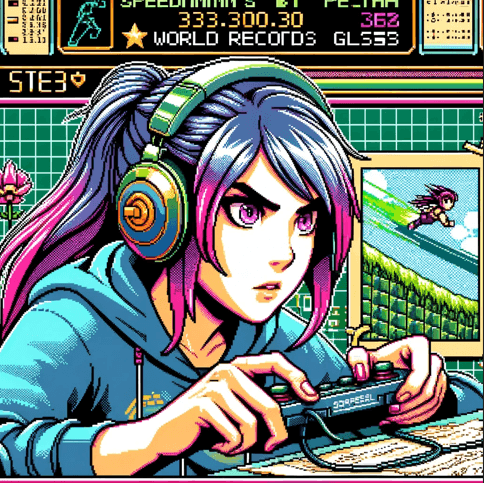 Hey, fellow gamers! Today, we’re diving into the Wandering Sword, a fantastic Chinese martial-arts RPG dished out by The Swordman Studio and published by Spiral Up Games. This game takes us on a mystical journey by blending traditional pixel art graphics and immersive 3D landscapes. This meshing of diverse art styles creates a unique backdrop for this Wuxia saga. I was particularly struck by the captivating storytelling, which someone mentioned it being like Octopath + Tactics Lite. So, thoughts?
Hey, fellow gamers! Today, we’re diving into the Wandering Sword, a fantastic Chinese martial-arts RPG dished out by The Swordman Studio and published by Spiral Up Games. This game takes us on a mystical journey by blending traditional pixel art graphics and immersive 3D landscapes. This meshing of diverse art styles creates a unique backdrop for this Wuxia saga. I was particularly struck by the captivating storytelling, which someone mentioned it being like Octopath + Tactics Lite. So, thoughts?
 I must admit, it grabbed me from the get-go. The innovative combat system, allowing players to switch between turn-based and real-time mode, caters to a pretty broad spectrum of gamers. Achieving martial prowess through mastering hundreds of martial arts techniques and weapon styles is a strategic feast for hardcore gamers like myself.
I must admit, it grabbed me from the get-go. The innovative combat system, allowing players to switch between turn-based and real-time mode, caters to a pretty broad spectrum of gamers. Achieving martial prowess through mastering hundreds of martial arts techniques and weapon styles is a strategic feast for hardcore gamers like myself.
 Agreed, and it seems like the devs put just as much thought into the game’s environment as well. Even if you’re speedrunning, you can appreciate the small, thoughtful interaction details they’ve woven in.
Agreed, and it seems like the devs put just as much thought into the game’s environment as well. Even if you’re speedrunning, you can appreciate the small, thoughtful interaction details they’ve woven in.
 For certain! The game’s landscapes and environments are an exploration paradise. You get over 75 different locations unified by the theme of ancient China. Also, I agree with the user who said that the game doesn’t force you to follow a mission checklist – the autonomy to choose quests adds depth to the game.
For certain! The game’s landscapes and environments are an exploration paradise. You get over 75 different locations unified by the theme of ancient China. Also, I agree with the user who said that the game doesn’t force you to follow a mission checklist – the autonomy to choose quests adds depth to the game.
 Speaking of depth, I found the game’s characters to be incredibly engaging, particularly the chance to recruit up to 14 unique martial artists. They all have their own personality traits and influence the narrative in their own
Speaking of depth, I found the game’s characters to be incredibly engaging, particularly the chance to recruit up to 14 unique martial artists. They all have their own personality traits and influence the narrative in their own
 Yes, the characters’ progression, the relationships you foster, and the influences on gameplay are remarkable. On the downside, some might find the game challenging, as one user noted the difficulty spikes might be annoying. However, I see those as rewarding milestones that keep the game inviting for those seeking a challenge.
Yes, the characters’ progression, the relationships you foster, and the influences on gameplay are remarkable. On the downside, some might find the game challenging, as one user noted the difficulty spikes might be annoying. However, I see those as rewarding milestones that keep the game inviting for those seeking a challenge.
 The fact that the game can be played either in real-time or turn-based mode means a single session can be speedrun, adding an extra layer of replayability. Plus, the game’s reliance on player decisions leading to multiple endings is an incentive to play through again and try different paths.
The fact that the game can be played either in real-time or turn-based mode means a single session can be speedrun, adding an extra layer of replayability. Plus, the game’s reliance on player decisions leading to multiple endings is an incentive to play through again and try different paths.
 Definitely, the branching paths and secrets make every replay a novel experience. The game’s expansive side quests, which supplement the main storyline, adds to that. Just a minor critique, I did find the menu UI could be more intuitive and polished. I wholeheartedly second that user’s feedback.
Definitely, the branching paths and secrets make every replay a novel experience. The game’s expansive side quests, which supplement the main storyline, adds to that. Just a minor critique, I did find the menu UI could be more intuitive and polished. I wholeheartedly second that user’s feedback.
 As we conclude today’s chat, let’s talk sound and audio. The game’s sound design perfectly accompanied the visual atmosphere, with music that brought that distinctive Chinese cultural vibe to life. The lack of clear direction on the impact of audio cues on gameplay was a minor blip in an otherwise immersive experience.
As we conclude today’s chat, let’s talk sound and audio. The game’s sound design perfectly accompanied the visual atmosphere, with music that brought that distinctive Chinese cultural vibe to life. The lack of clear direction on the impact of audio cues on gameplay was a minor blip in an otherwise immersive experience.
 Wandering Sword has indeed set a high benchmark in the Chinese Themed RPG genre, making it even rival well-established JRPGs. I’d love to see a sequel, maybe one that broadens the martial arts realm even further.
Wandering Sword has indeed set a high benchmark in the Chinese Themed RPG genre, making it even rival well-established JRPGs. I’d love to see a sequel, maybe one that broadens the martial arts realm even further.
 Given that this is a title by The Swordman Studio, we can be sure there’s more where this came from. Here’s hoping they keep innovating and enthralling us with more complex and interactive environments in the future.
Given that this is a title by The Swordman Studio, we can be sure there’s more where this came from. Here’s hoping they keep innovating and enthralling us with more complex and interactive environments in the future.
 Indeed, it’s always exciting to see developers like these pushing boundaries and conceiving fresh ideas in their future projects. I eagerly await what comes next from The Swordman Studio. My hope it will continue the tradition of delivering a thoroughly designed Wuxia world teeming with intricate quests and vibrant narratives.
Indeed, it’s always exciting to see developers like these pushing boundaries and conceiving fresh ideas in their future projects. I eagerly await what comes next from The Swordman Studio. My hope it will continue the tradition of delivering a thoroughly designed Wuxia world teeming with intricate quests and vibrant narratives.
 Well, here’s to The Swordman Studio, keep those adventures coming!
Well, here’s to The Swordman Studio, keep those adventures coming!
